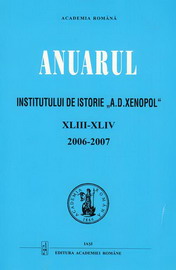The treaty of Paris (1856) and the Bolgrad crisis of its execution
The treaty of Paris (1856) and the Bolgrad crisis of its execution
Author(s): Dumitru VitcuSubject(s): History
Published by: Editura Academiei Române
Keywords: european crisis; Russian-Turkish condominium
Summary/Abstract: To return to the region under discussion, the delimitation of the South- Bessarabian border between the two empires, the Russian and the Turkish, with the direct involvement of the Romanian space and authorities, was considered by Gaston de Monicault “a less important part of the peace treaty,”79 but only by reference to appearances. In fact, the matter proved to be a real touchstone, at first for the relations among the former allies, who were now led by disjointed objects and interests, then for the anticipated bilateral connections of each of them with the common adversary, Russia.80 The latter was determined, beginning with the very first day after the congress, to recover as fast as possible its international prestige and the damage caused by the war. Against such a background, the Romanian Principalities – freed from under the Russian-Turkish condominium and placed under the collective warrant of the European powers – could not wish for more81 than they were offered by the competition of vainglories and the game of interests played by the great actors; and it was against the same background that the Principalities continued to be an object (somehow privileged) of the international relations.
Journal: Anuarul Institutului de Istorie »A.D. Xenopol« - Iaşi
- Issue Year: 2006
- Issue No: 43+44
- Page Range: 335-354
- Page Count: 19
- Language: English

